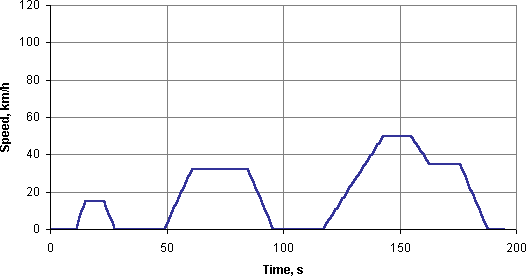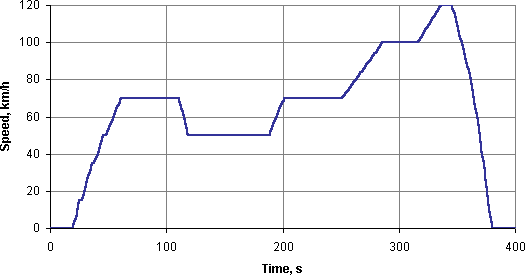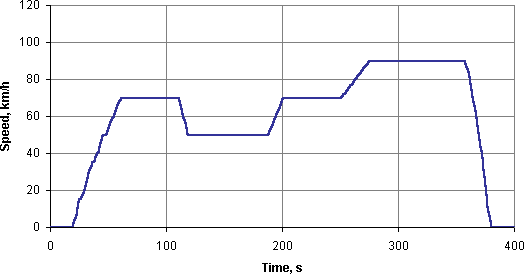"The ECE+EUDC test cycle is performed on a chassis dynamometer. The cycle—also known as the MVEG-A cycle—is used for emission certification of light duty vehicles in Europe [EEC Directive 90/C81/01].
The entire cycle includes four ECE segments, Figure 1, repeated without interruption, followed by one EUDC segment, Figure 2. Before the test, the vehicle is allowed to soak for at least 6 hours at a test temperature of 20-30°C. It is then started and allowed to idle for 40s.
Effective year 2000, that idling period has been eliminated, i.e., engine starts at 0s and the emission sampling begins at the same time. This modified cold-start procedure is also referred to as the New European Driving Cycle or NEDC.
Emissions are sampled during the cycle according the the “Constant Volume Sampling” technique, analyzed, and expressed in g/km for each of the pollutants.

Cumprimentos
Figure 1. ECE 15 Cycle
The ECE cycle is an urban driving cycle, also known as UDC. It was devised to represent city driving conditions, e.g. in Paris or Rome. It is characterized by low vehicle speed, low engine load, and low exhaust gas temperature.
The above urban driving cycle represents Type I test, as defined by the original ECE 15 emissions procedure. Type II test is a warmed-up idle tailpipe CO test conducted immediately after the fourth cycle of the Type I test. Type III test is a two-mode (idle and 50 km/h) chassis dynamometer procedure for crankcase emission determination.

Figure 2. EUDC Cycle
The EUDC (Extra Urban Driving Cycle) segment has been added after the fourth ECE cycle to account for more aggressive, high speed driving modes. The maximum speed of the EUDC cycle is 120 km/h. An alternative EUDC cycle for low-powered vehicles has been also defined with a maximum speed limited to 90 km/h (Figure 3).

Figure 3. EUDC Cycle for Low Power Vehicles"
Em: http://www.dieselnet.com/standards/cycles/ece_eudc.html